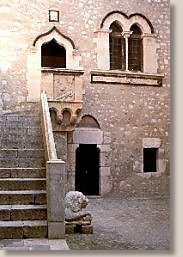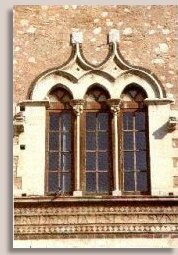
 
Corvaja Palace
It takes the name from the Corvaja family, one of the most ancient and noble families of Taormina, which possessed it from 1538 to 1945. It rises in Abbey square and is the most important medieval palace of which the town boasts. It has an Arabic style and at the same time Gothic and Norman, turned out from transformations brought by various dominations. The battlements of the tower, composed from a double series of square holes, surmounted from little merlons, were made by Arabian craftsmen, while Gothic the mullions (windows with two lights) in the fourteenth-century saloon, Norman the fifteenth-century room (lit up by four mullions and by one window with three lights) where the reunions of the  Sicilian Parliament took place. Sicilian Parliament took place.
Initially it was an Arabian tower, built for military purposes. The tower was widened at the end of the thirteenth century with the addition of the main body to the left of the entry portal and with the addition of the entry staircase, which from the courtyard leads to the first floor. In the landing there are three splendid panels made with the stone from Siracusa, graven in high relief, which represent the first The creation of Eva, the second The original sin and the third The expulsion from Heaven. The right wing of the Palace was realized at the beginning of the fifteenth century to allow the reunions of the Sicilian Parliament. The first reunion was held in August 1409 to elect, after the death without heirs of Martin junior, the new King of Sicily (named then King Martin senior, who left the regency of Sicily to the daughter in law Bianca from Navarra). Subsequently the reunions were held in the big fifteenth-century saloon (where there is a fresco which represents Daniel in the lions' den) with the presence of the Queen Bianca from Navarra. For these reasons the Palace was called both the Parliament' Palace and the Queen Bianca from Navarra Palace.
In 1946 the Palace was restored by the architect Dillon.
|

